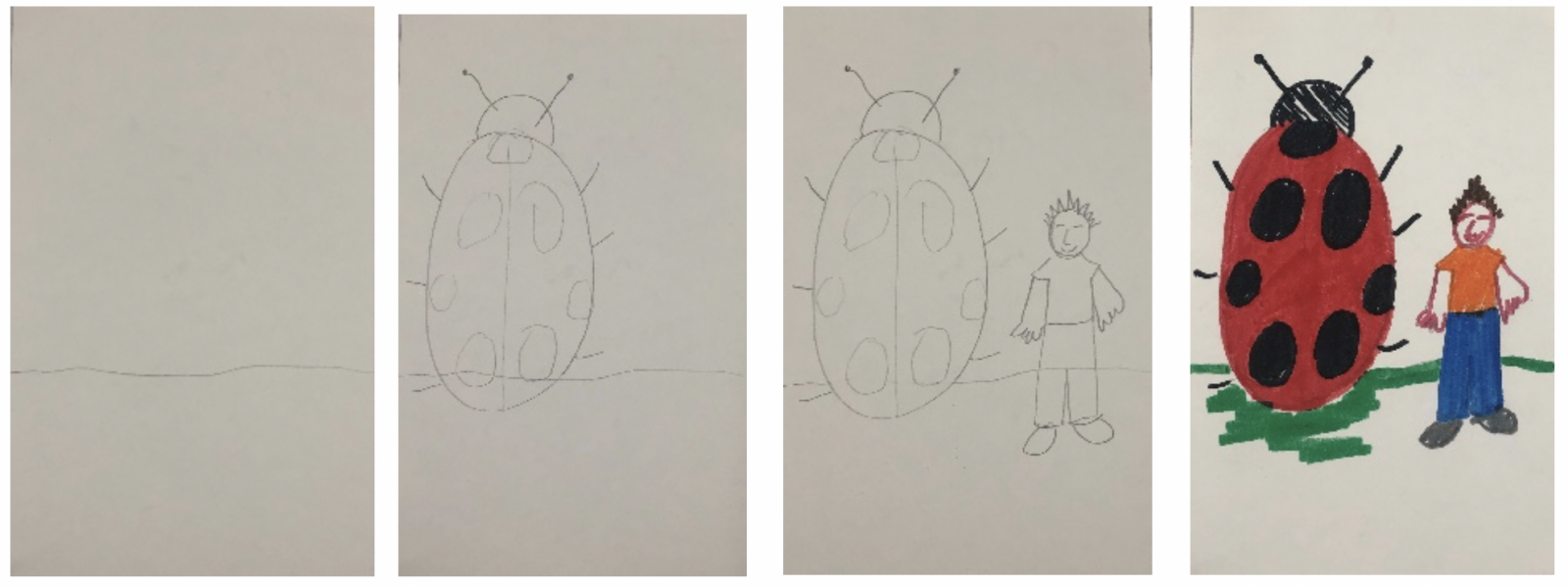After learning about visual scale, students will create a drawing that is out of scale. Recommended for 2nd Graders.
Color: the visible range of reflected light.
Line: a long narrow mark or stroke made on or in a surface.
Shape: a two-dimensional (flat) area enclosed by a line.
Contrast: refers to the arrangement of opposite elements, or using very different qualities next to each other to create visual interest, excitement and drama. In this lesson the shape’s expected sizes contrast, creating visual excitement.
Scale: the size of a whole object compared to another whole object or its environment.
Craftsmanship: A way of working that includes following directions, demonstrates neatness and the proper use of tools.
Sketch: a quickly made or loose interpretation of the intended drawing. Holding the pencil loosely and making multiple marks until some of them are what you want.
Surrealism was an art movement that developed between World War I and World War II. Artists would use everyday objects in unexpected ways to surprise the viewers. One of the ways they did this was to play with scale. They created visual excitement by combining objects that were completely out of scale in relationship to each other (too big or too small). These extreme contrasts and detachment from reality made an optical illusion, meant to confuse and amuse viewers.
.jpg) Magritte, The Reading Room
Magritte, The Reading Room
Find an image of Magritte’s The Reading Room (see above) to show the students.
Scale describes how large or small something is in relationship to its environment. comparing one object to another helps us determine its size because we are accustomed to certain size relationships.
In real life is a person smaller or larger than a building? How about an ant and a tree, which is smaller?
Would you be surprised if you saw an ant the size of dog? Or a tree the size of a mountain? What else could be surprising? What other reactions does it produce? Amusement, unease, fear, confusion?
Students will:
Post the vocabulary words and briefly go through them. Refer to these words during the lesson.
Demonstrate: You are will draw a person in an environment, and something else (an animal, a building, a plant or any everyday item) whose size we already know. You can decide which thing should be comparatively ‘out of scale.’ You want the viewer to wonder which one is too big or too small for its environment. Talk about the process as you go.

Lesson written by Juliette Ripley-Dunkelberger.
Henry, Sandi, and Sarah Rakitin. Cole. Making Amazing Art!: 40 Activities Using the 7 Elements of Art Design. Williamson Books, 2007.
21st Century Thinking Skills
Thinking flexibly, persisting, questioning, creating, innovating, listening with empathy, taking responsible risks, observing, making connections, visualizing, sequencing, predicting, comparing/contrasting, determining main idea, finding evidence, problem solving, cause and effect, determining point of view, decision making.
WA State Learning Standards
(VA:Cr1.1.2) a. Brainstorm collaboratively multiple approaches to an art or design problem.
(VA:Cr3.1.2) a. Discuss and reflect with peers about choices made in creating artwork. This happens if you have time to share drawings.
(VA:Pr4.1.2) a. Categorize artwork based on a theme or concept for an exhibit.
(VA:Re7.1.2) a. Perceive and describe aesthetic characteristics of one’s natural world and constructed environments.
(VA:Re8.1.2) a. Interpret art by identifying the mood suggested by a work of art and describing relevant subject matter and characteristics of form. The mood of out of scale juxtapositioning can be confusion, unease, amusement.
(VA:Cn11.1.2) a. Compare and contrast cultural uses of artwork from different times and places. This happens if you talk about the meaning of Surrealism in its era—intended to shake up the concept that art should depict real life (it doesn’t have to).
Arts Integration Opportunities
Read a map’s scale guide.
Observe realistic toys who are built to scale: e.g. dollhouse, train set.
Story prompt about their “object of unusual scale”.
Please note: These lesson plans are intended for non-profit use only. Use of these plans for commercial purposes should give attribution to the Issaquah Schools Foundation and be accompanied by a nominal donation at www.isfdn.org/donate. Thank you.
Fueling Success for Every Student, Every School